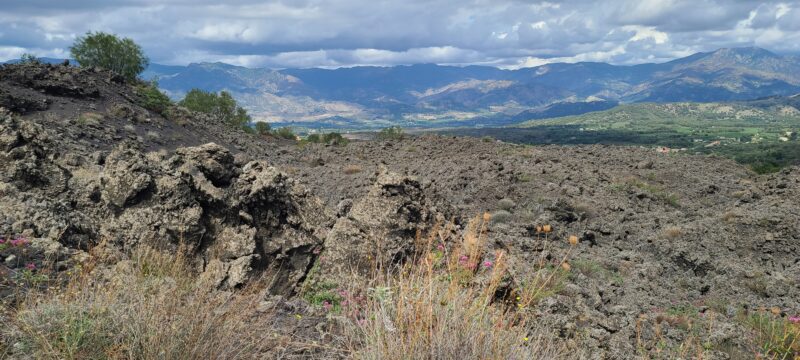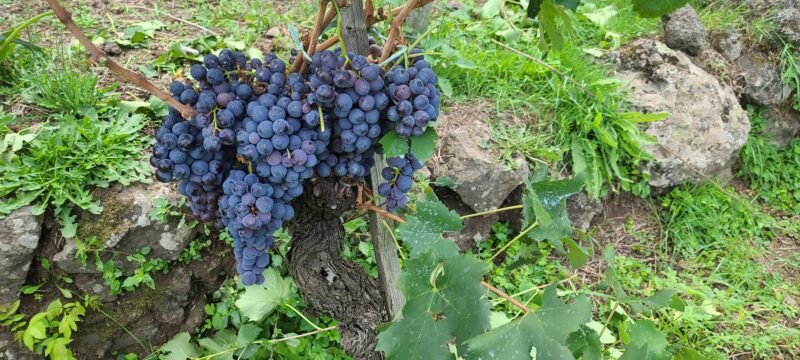
Living in the shadow of Mount Etna, Europe’s highest active volcano, in the time of global climate change may sound daunting to many communities. But for Sicilians it is both an opportunity and a blessing when it comes to making wine. Volcanic soils produce some of the most terroir-driven wines in the world. Called “A Muntagna” in Sicilian dialect, Etna soars 11,000 feet (3,357 meters), puffing billows of smoke and gas much of the time and giving a few rumbles and jolts to remind everyone that this millennia-old force of nature still knows how to rumble. On average, Etna emits more than 500,000 tons of ash when she decides to erupt. That creates a mountainous amount of natural fertilizer.

Lava fields
Each lava field around Etna tells a story. Geologists have analyzed, measured, dated and mapped every lava field, noting its impact on the local environment. One of the larger lava fields we drove through was from 1981, and we tasted wines dated “1614” at Vini Franchetti and Planeta, which both lie in a lava flow from the eruption of – you guessed it – the year 1614. These dates matter. While the larger lava fields themselves appear inhospitable, the sandy ash and rocky debris produce mineral-rich soil. Each eruption changes the mineral composition of the soil which impacts the unique geographical identity of the contradi, carefully mapped districts throughout Sicily. This soil is also resistant to the vine disease, phylloxera, which is why one can find many old gnarled un-grafted vines dating back more one hundred years.
What’s Old Becomes New Again
Winemaking in Etna dates back centuries. Many families had a backyard or neighborhood palmento, a rustic stone building where grapes would be gathered, sorted, crushed by foot and then fermented into wine. Old palmenti still exist throughout Etna DOC. Some have been restored and converted into tasting rooms, restaurants, and wine museums. One we saw at Palmento Costanza has been restored and retrofitted into a modern functioning winery facility.

Palmento Costanza’s modernized palmento
The Etna DOC (Denominazione di Origine Controllata) was established in 1968 to set quality and production guidelines for the region’s wine. These include what grapes may be used, where they are sourced, vineyard locations including altitude restrictions, level of alcohol and other factors.
In the second half of the 20th century, Sicilian wines including those from Etna DOC became more accessible to the international market, thanks to the introduction of more investments in the region, upgrades to winemaking facilities, an increase in bottling production and more interest among importers and wine consumers alike, including those in the United States.
Today there are more than 200 Etna DOC producers. Many are family-owned wineries including grape growers who only started bottling their wines in the late 20th century. Others are young entrepreneurs who have invested in vineyard land to start wineries. This includes women, who comprise around eight percent of Etna’s producers according to the Tutela Vini Consorzio Etna DOC.

Manuela Seminara, Founder of Tenute Ballasanti.
Contrada: A Sense of Place
Etna DOC’s four production zones are subdivided into individual contrada, a district which indicates a specific geographical area. Each contrada has a distinct microclimate that is impacted by various conditions including volcanic soil composition, altitude, temperature variations, humidity and other factors. A contrada designation on a bottle is similar to a Unità Geografiche Aggiuntive (UGA) in Tuscany or a climat in Burgundy. Etna DOC bottles will contain the name of the contrada to identify the wine’s specific geographic indication. Wineries throughout Etna DOC may own or source grapes from vineyards located in a single or many different contradi.
Geographically Etna North is home to several notable contradi with some of the highest elevation vineyards. DOC guidelines require that all wines are sourced from vines at a maximum 900 meters, just under 3000 feet altitude. The diurnal temperature shift creates an ideal environment for grapevines, and there are many well-known producers here. Etna Nord is well-regarded for its red wines made from two native varieties, Nerella Mascalese, the dominant red, and Nerello Cappucio, which is usually added in smaller percentages – most-times averaging about 5-10% – to add depth and color.

Clusters of Nerello Mascalese
Both reds and whites are made throughout all the Etna DOC production zones. However, the warmer coastal regions to the East and South are particularly recognized for their whites. The two main white varieties are Carricante and Catarratto. Carricante produces a crisp white wine, with citrus and herbaceous notes akin to Pinot Grigio or a Sauvignon Blanc. Catarratto is frequently blended in small amounts – maximum allowed is 40% – with Carricante to add floral and fruity notes to the wine. Most Etna DOC whites we tasted were an 80-20 blend of Carricante and Catarratto. Etna Bianco Superiore is produced in the Milo commune in the East. This wine is also a Carricante bianco dominant blend but with a slightly higher concentration of alcohol, a deeper yellow hue and more intense fruit and floral notes.

Carricante clusters
Our trip was hosted by the Consorzio Tutela Vini Etna DOC. Entitled “Etna Days,” the trip included lectures, tastings and visits to wineries. We decided each chose separate itineraries for the producer tours which we document in the next post.
We also spent an additional five days traveling throughout Etna Nord to visit more producers and historic lava fields and sightsee. The weather was late summer warm with cooler mountain nights. The vines were bursting with ripe grapes; harvest was just a few weeks away. We hiked mountain slopes at the Etna Natural Park located off the “Quota Mille,” the high mountain road stretching from Castiglione di Sicilia to Randazzo.
Here is the itinerary we created ourselves after Etna Days.
Transportation:
We rented a car from Avis at the Catania Airport. We drove around the south and west side of Etna from Cantania Airport to Randazzo. The drive is beautiful. A highlight is passing through the pistachio fields around Bronte. These highly prized pistachios can be found in many savory and sweet dishes and make a great gift to take home.
Stay:
Etna Quota Mille is a stunning, well-located agriturismo located within a large lava field on Etna North off the Quota Mille road. The structures date to the 19th century and are well-modernized. We stayed in a two story one-bedroom suite. There is a large outdoor swimming pool, a very good restaurant. The hotel will help arrange day excursions to hike to an Etna crater, take mule ride and visit wineries. Trust us when you say, the hiking is practically at your footsteps here at the Etna Parco Natural down the road. We only stayed one night but suggest using this hotel is a base to explore the area. Etna Quota Mille, Rural tourism on Etna | Restaurant, Swimming pool, Rooms

Etna Quote Mille Agriturismo swimming pool
L’Arco dei Sogni (“the arch of dreams”) is a hilltop bed and breakfast located near a large archway in the tiny, walkable town of Malvagna, not far the from the larger town of Castiglione di Sicilia (where we had lunch that day). There are stunning views of the Nebrodi Mountains from this town and some very good hiking. Otherwise, it is a quiet village. Macelleria Ristorante Grigliera da Nino is a butchery and restaurant receives high marks.
There are steps and no elevator at L’Arco dei Sogni. Choose a room with a patio to enjoy a stunning view of the volcano. Luigi, the owner, only speaks Italian, so we did our best to use our Duolingo skills. The large breakfast was an assortment of homemade cakes and pastries along with a savory table of salumi, cheeses, mushrooms, tomatoes and picked vegetables. We packed a picnic. L’Arco dei Sogni | Hotel Etna, Alberghi sull’Etna | Malvagna

Breakfast at L’Arco dei Sogni
Azienda Parco Statello is a large country inn with a restaurant located next to a beautiful park by the same name. We have a large apartment for our one-night stay and generous breakfast the next morning. We had time to stroll around the park before dinner. Unfortunately, the restaurant was not open the night we stayed, so we dined in nearby Randazzo. Our history (parcostatella.com)
Next door to Parco Statello is Donnafugata Winery, one of the six estates in Sicily owned by the Rallo family. The glass enclosed tasting room offers beautiful views of the vineyards. Etna Wine Tasting Tours, Sicily at Donnafugata Cellars

Visit/Dine
Palmento Costanza Winery, located in the Contrada Santo Spiritu, is a popular family-run winery in Etna DOC Nord and a great place to visit for a tasting and lunch, which we enjoyed. On site are several restored buildings on the property, including the working modernized palmento mentioned earlier. Owner Valerie D’Agosto is a gracious host, and her wines are elegant and well-balanced, among our favorites in this area.

Palmento Costanza offers wine tastings and lunch at its winery in Contrade Santo Spiritu

At Valeria’s suggestion, we dined at Cave Ox a wine bar and restaurant popular among Etna winemakers in the nearby hamlet of Solcchiata. Cave Ox’s Sandro Dibello was on-hand to take our order and recommend wines and local beers. The wine list is extensive. We also had a moment of serendipity as we ran into a fellow American wine writer having lunch with her mother and a local winemaker. www.caveoxristorante.com

Dining al fresco at Cave Ox
Randazzo is a walkable medieval city with many small restaurants and markets. It is a good starting point to drive the Quota Mille. In Randazzo, we dined with Planeta Executive Winemaker Patricia Toth at Ristorante San Giorgio e il Drago. The menu is strong on grilled meat and pasta dishes as is much of the fare in area.

Pasta with seasonal wild mushroom
Castiglione di Sicilia is a hilltop town with beautiful views and steep, narrow streets. We visited for the day and had lunch at La Dispensa dell’Etna which served simple Sicilian fare. Most of the food we had was fairly simple, meat-hearty and seasonal. When we plan as return visit, it will include the town of Linguaglossa for a meal at Michelin-starred Shalai. This restaurant is located in a luxury boutique hotel by the same name.
We enjoy hiking and there were plenty of options at the Parco dell’Etna (free access). We used the opportunity to pack picnics with local cheese, fruits and breads and then walk off some calories.


Parco dell’ Etna
You can also base in Taormina which is a gorgeous seaside resort city on the coast and hire drivers to tour you. Taormina served as a setting for episodes of the HBO television series “The White Lotus.” We were told that series has driven tourism to the area, and some tour companies offer “White Lotus” excursions.
However, we suggest taking the time to slowly explore and savor Etna and all it has to offer. You can book a day trip to summit the volcano or choose a sunset hike. We did this during our first Etna Days visit, and it is well worth it. Fun fact: you can ski Mount Etna during the winter.
If you arrive or depart from the Catania airport, take time to explore. After dropping off our rental car, we spent an overnight in Catania which is easy to walk about. The bustling open-air fish market and historical center with its beautiful Baroque churches are both worth spending the time and staying a night (or two). There are many restaurants to try and beautiful port to stroll. Fun fact: The elephant is the symbol of Catania, and one can find statues around the city. This pachyderm has mystical powers according to local lore. For more read: Elephant Fountain – Catania, Italy – Atlas Obscura.

